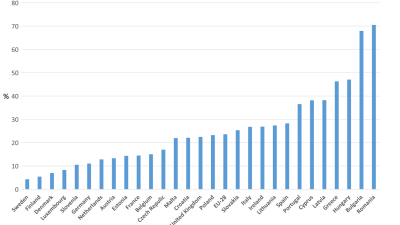We are used to reports by academics and think tanks examining the consequences of austerity for households. Now it seems the Bank of England has been doing its own evaluation. And its results show very clearly how austerity has hit the poorest hardest, along with families with children and people with long-term health problems or disabilities.
Other studies have used data on household incomes to examine the distributional impacts of austerity – see for example, the Resolution Foundation’s excellent analysis of changes in incomes since the recession.
Using data from income surveys gives the analysis a certain objectivity but it also makes it quite limited. Such an approach can only look at the impact on cash incomes from changes in earnings or benefits. Yet austerity is resulting in deep cuts in public services which have direct impacts on well-being, and there is strong evidence that these cuts fall most heavily on low-income groups. Many thousands of public service workers have been made redundant while those who remain face the stress of trying to cope with rising levels of need with fewer and fewer resources.
The Bank of England has taken a more rounded approach, through its regular household survey – the NMG survey. With 6000 responses, it has a sizeable sample and, in a welcome move, it makes the data freely available on-line so anyone can analyse it for themselves.
In September 2015, the Bank asked households to focus on the government’s policies to reduce the budget deficit and to evaluate the impact of all these measures on themselves. It asked the question:
“Since 2010, the government has announced a succession of measures in order to cut the country's budget deficit. How have these measures affected your household over the past 5 years?”
Clearly, this is asking quite a lot of people and, unsurprisingly, one in six people were unable (or unwilling) to say. Of the remaining 5000, a third felt they had been affected negatively while most of the rest felt there had been no impact. Just 4 per cent said they had been positively affected.
So who is more likely to report negative impacts? The 'Impacts of austerity' graph downloadable below or linked to here provides a summary. First, it is those on low incomes – 47 per cent of those in the bottom fifth, compared with 29 per cent in the top fifth, with a steady gradient in between. Low income groups have borne the brunt of the cuts in both welfare benefits and public services.
There are notable differences by tenure with renters, particularly social renters, reporting more negative impacts. This may be in part an income effect but may also reflect the impacts of rapidly rising rents in that sector.
Looking at age groups, it is no surprise perhaps that pensioners are the least likely to report being negatively affected (just 25 per cent). As the Resolution Foundation report shows, benefit spending per head for this group has risen since 2008, thanks largely to the ‘triple lock’ protection offered by the Conservatives - whereas it has fallen for working age adults and for children. Pensioners are greater users of public services such as health and social care, but the former at least has enjoyed significant protection.
Much more surprising is that young adults 18-24 are also less likely than average to feel negatively affected (28 per cent). This is the group which has not only been hardest hit by rising unemployment but has also seen the greatest reductions in welfare benefits.
The age group most concerned by austerity are the middle aged, from 35 to 64 (46 per cent). People with children are also more likely to report negative impacts, and there is a strong overlap here. This is the group who have lost most from cuts in welfare benefits associated with children, and are perhaps also more directly affected by the loss of non-statutory public services like youth clubs and play schemes, or cuts in services such as libraries.
Another group reporting substantially worse impacts are working age people with long-term sickness or disability where a striking two-thirds report negative effects. This is a group with great reliance on both welfare benefits and key public services, such as social care.
Finally, there is a curious regional pattern to the data. People in Scotland were more likely to feel negatively affected than those in any other region. The Resolution Foundation analysis shows that, for the working age at least, Scots had been least affected in the UK in terms of income changes so it isn’t a spillover from economic problems. And it is unlikely to reflect differences in policy in Scotland which have, after all, been pretty minor; health has been squeezed a bit more, local government a bit less. Perhaps this is a political effect. Where Labour had seemed unable or unwilling to offer a coherent critique of the Conservative’s ‘austerity’ agenda – at least until Jeremy Corbyn’s election as leader - the SNP had been vocal and direct. The approach appears to have had a political pay-off.
Nick Bailey is Professor of Urban Studies, University of Glasgow
Twitter: @nickbailey37



 PSE:UK is a major collaboration between the University of Bristol, Heriot-Watt University, The Open University, Queen's University Belfast, University of Glasgow and the University of York working with the National Centre for Social Research and the Northern Ireland Statistics and Research Agency. ESRC Grant RES-060-25-0052.
PSE:UK is a major collaboration between the University of Bristol, Heriot-Watt University, The Open University, Queen's University Belfast, University of Glasgow and the University of York working with the National Centre for Social Research and the Northern Ireland Statistics and Research Agency. ESRC Grant RES-060-25-0052.






